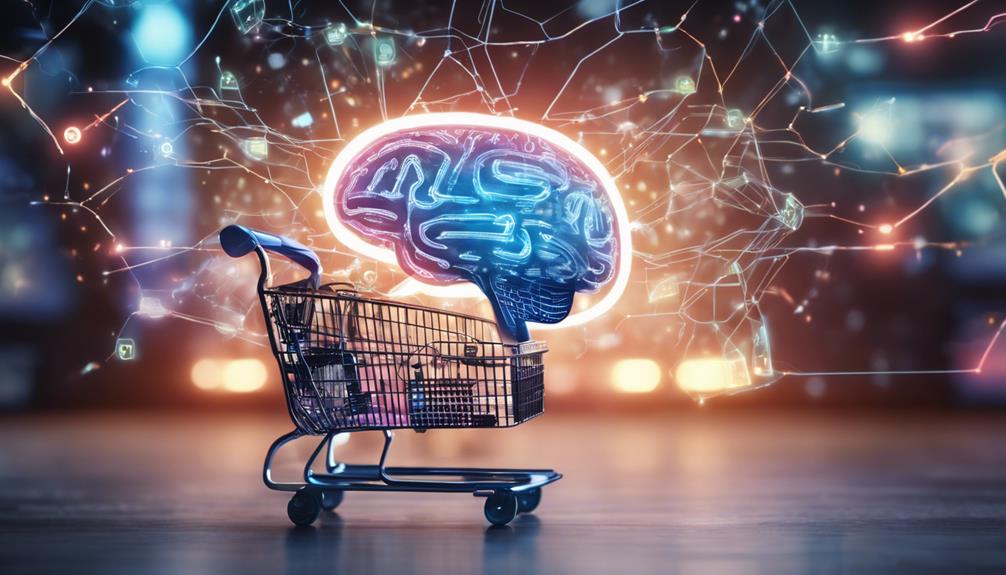You're now operating in a world where AI-driven cybersecurity systems can detect and predict cyber attacks before they even happen, leaving cybercriminals, aka 'black hats,' frustrated and scrambling to keep up with the latest defensive technologies. These self-learning AI systems analyze vast amounts of data to identify patterns and forecast threats, enabling proactive security measures that stay ahead of malicious actors. With AI-driven tools automating threat detection and response in real-time, you can greatly reduce the time it takes to detect and respond to incidents, saving financial losses. As you explore this emerging landscape, you'll discover the cutting-edge innovations and strategies that are redefining the cybersecurity race.
Key Takeaways
- AI-powered predictive analytics identify patterns in vast data to forecast cyber threats before they materialize, staying ahead of malicious actors.
- Self-learning AI-driven tools automate threat detection, analyzing data in real-time to identify threats and enhance defense mechanisms against potential breaches.
- Predictive models, similar to those used in smart cars, inform decision-making in threat detection, reducing the time to detect and respond to incidents.
- Continuous monitoring and analysis are essential to combat ransomware and evolving threats, emphasizing the importance of cyber resilience in the current threat landscape.
AI Predicts Cyber Attacks
As you navigate the complex cybersecurity landscape, self-learning AI technologies stand out for their ability to analyze vast amounts of data and identify patterns and anomalies that can predict potential cyber threats before they materialize.
By leveraging predictive analytics, AI can forecast cyber attacks by recognizing deviations from normal behavior, greatly enhancing your organization's proactive security measures. This means you can stay one step ahead of malicious actors, detecting potential threats before they cause harm.
With AI-driven solutions, you can reduce the time to detect and respond to incidents, potentially saving your company from substantial financial losses and reputational damage.
The importance of AI in predicting cyber attacks can't be overstated, as traditional defenses are no longer enough to protect against evolving threats.
Ransomware and Cybersecurity Threats

As you explore the domain of ransomware and cybersecurity threats, you'll quickly realize that these malicious attacks can infiltrate your systems through various vectors, including phishing, vulnerable websites, and unpatched software.
You'll need to shift your security mindset to focus on detecting threats after they've breached your defenses, rather than solely trying to prevent unauthorized access.
Ransomware Attack Vectors
You're likely to encounter ransomware attacks through familiar channels, including phishing emails, unpatched software vulnerabilities, and compromised websites, which underscores the importance of robust security measures.
These vectors are nothing new, but the sophistication of ransomware actors has increased substantially, as seen in Advanced Persistent Threats (APTs) like the SolarWinds attack.
To stay ahead, you need a proactive approach that leverages machine learning to identify deviations from normal behavior patterns, enabling quick detection of potential ransomware breaches.
This cyber resilience is vital in today's threat landscape.
Post-Breach Detection Philosophy
In today's complex threat landscape, adopting a post-breach detection philosophy is essential to staying one step ahead of ransomware actors, who often evade traditional preventive measures. You need a proactive approach that assumes a breach has already occurred, and focuses on detecting and responding to threats in real-time. This shift in philosophy emphasizes the importance of self-learning AI, which plays a vital role in identifying deviations from normal operational patterns, indicating an ongoing ransomware attack.
| Benefits of Post-Breach Detection | How AI Enhances Post-Breach Detection |
|---|---|
| Early threat detection and response | Identifies patterns and anomalies in real-time |
| Reduced dwell time and attack surface | Autonomous Response systems neutralize threats early |
| Improved incident response and containment | AI-driven insights inform incident response strategies |
| Enhanced threat hunting and remediation | AI-powered analytics identify root causes and vulnerabilities |
| Increased security team efficiency and effectiveness | AI-driven automation streamlines threat response and remediation |
Vulnerable Software Exploitation
Ransomware actors constantly exploit vulnerable software, using it as a gateway to infiltrate your systems and launch devastating attacks. You're likely aware that unpatched software is a cyber criminal's best friend, and they won't hesitate to take advantage of it. In fact, vulnerable software exploitation remains a primary entry point for ransomware attacks, often via phishing or exploited websites. Cyber criminals know that if they can find a weak link in your software, they can use it to gain access to your entire system.
To stay one step ahead, it's crucial to prioritize software updates and patches. This isn't a one-time task; it's an ongoing process that requires constant vigilance.
Additionally, implementing a thorough security strategy that includes zero trust and strong authentication measures can help prevent supply chain attacks like the SolarWinds incident. By staying proactive and addressing vulnerabilities before they're exploited, you can greatly reduce the risk of ransomware attacks and keep your systems safe from cyber criminals.
AI-Driven Attack Automation

As you explore the domain of AI-driven attack automation, you'll discover how it's revolutionizing the cybercrime landscape.
You'll see how AI-assisted phishing campaigns are becoming increasingly sophisticated, with automated breach attempts that can evade even the most robust security measures.
Meanwhile, ransomware evolution tactics are also getting a boost from AI, making it even more essential for you to stay ahead of these emerging threats.
Ransomware Evolution Tactics
Cybercriminals are now leveraging AI-driven automation to launch sophisticated ransomware campaigns with unprecedented speed and stealth, making it easier for you to fall victim to these attacks. The ransomware evolution has enabled low-skilled hackers to participate in such attacks, making the threat landscape more treacherous. AI systems can generate convincing phishing emails and automate targeting of vulnerable systems, increasing the scale and effectiveness of ransomware operations.
| Ransomware Evolution | AI-Driven Capabilities | Consequences |
|---|---|---|
| Increased Speed | Automated phishing email generation | Higher success rates |
| Improved Stealth | Real-time adaptation to evade detection | Delayed threat detection |
| Enhanced Scale | Targeted attacks on vulnerable systems | Wider attack surface |
With AI-driven automation, Advanced Persistent Threats (APTs) can orchestrate multi-stage attacks that compromise entire networks before defenses are triggered. To combat this, organizations must shift to proactive threat detection methodologies, focusing on identifying and neutralizing threats after breaches occur. The stakes are high, and it's crucial to stay ahead of these evolving ransomware tactics to protect your organization from devastating attacks.
AI-Assisted Phishing Campaigns
You're now facing a more formidable foe in AI-assisted phishing campaigns, where machine learning algorithms analyze vast datasets to craft tailored, convincing messages that greatly increase the success rate of phishing attempts.
This AI-driven attack automation reduces the need for human involvement, allowing low-skilled attackers to launch sophisticated campaigns with minimal effort.
What's more, AI can generate thousands of phishing emails in a matter of minutes, employing natural language processing techniques to mimic the tone and style of legitimate communications.
With 91% of cyberattacks starting with a phishing email, it's a critical area of concern for cybersecurity professionals.
As AI continues to evolve, its ability to enhance social engineering tactics will escalate, leading to more effective impersonations and increased difficulty for individuals and organizations to identify malicious communications.
You must be vigilant, as AI-assisted phishing campaigns will only get more sophisticated, making it essential to stay ahead of these threats.
Automated Breach Attempts
Beyond phishing campaigns, AI-driven attack automation takes cyber threats to the next level, enabling malicious actors to launch devastating large-scale breaches with unprecedented speed and precision.
You're now facing a cybersecurity landscape where automated breach attempts are the new norm. With AI-driven tools, cybercriminals can execute complex attacks with minimal human intervention, increasing the frequency and sophistication of threats. You'll see a significant rise in successful breaches across various sectors, even from low-skilled hackers.
AI-powered automation enables the coordination of numerous botnets to launch Distributed Denial of Service (DDoS) attacks, overwhelming targeted systems simultaneously. Advanced techniques like generative adversarial networks (GANs) are used to create realistic deep fakes, manipulating public opinion or facilitating social engineering attacks.
As you navigate this treacherous cybersecurity landscape, it's essential to stay ahead of these automated breach attempts. The AI that predicts cyber attacks before they happen is your best defense against these sophisticated threats. With its ability to detect and respond to attacks in real-time, you can rest assured that your security is in good hands.
Cybersecurity Innovations and Initiatives

As the cybersecurity landscape evolves, innovations and initiatives are revolutionizing the way organizations defend against threats, with cutting-edge technologies and strategic partnerships emerging as key players in the fight against cyber attacks.
You're probably aware that generative AI is being used to enhance threat detection capabilities, allowing systems to adapt to normal organizational patterns and rapidly detect unpredictable attacks. But what about Zero Trust architectures, which assume that all networks and systems are compromised, and verify every access request? These innovations are essential in today's cybersecurity landscape.
| Innovation | Description | Benefit |
|---|---|---|
| DARPA's SSITH | Enhances hardware security | Prevents software vulnerabilities |
| Self-learning AI | Adapts to normal patterns | Rapidly detects unpredictable attacks |
| ExtraHop Acquisition | Bolsters resources for threat detection | Improves response capabilities |
| CrowdStrike & AWS | Automates response measures | Enhances detection capabilities |
These initiatives and partnerships are transforming the way you defend against cyber attacks. By leveraging behavioral analytics and machine learning, Next-Generation Detection and Response (NDR) solutions are becoming increasingly effective, especially in cloud environments.
Strategic Developments in Cybersecurity

With cybersecurity expenditure projected to reach $150 billion annually, strategic developments in the field are vital for organizations to stay ahead of sophisticated cyber threats. As you navigate the complex landscape of cybersecurity, you'll notice that innovative partnerships and acquisitions are driving progress. For instance, ExtraHop's acquisition by Bain Capital and Crosspoint Capital aims to enhance advanced threat detection and response capabilities.
Here are some key strategic developments to watch:
- Advanced threat detection: Partnerships like ExtraHop with CrowdStrike and AWS focus on automating response processes to strengthen detection capabilities.
- NDR solutions: The rise of Network Detection and Response solutions, driven by behavioral analytics and machine learning, is essential for protecting perimeter-less enterprise IT environments.
- Integrated security analytics: Splunk Security Cloud integrates advanced security analytics and automated operations with TruSTAR to improve threat intelligence and streamline response strategies.
These strategic developments are essential for organizations to stay ahead of sophisticated cyber threats and protect their networks from evolving attacks.
Evolving Cyber Threats and Responses

You're facing a rapidly evolving threat landscape, where the shift to cloud solutions during the COVID-19 pandemic has exposed significant security gaps and underscored the need for enhanced cloud-centric access management and security monitoring. As you navigate this complex landscape, it's crucial to prioritize thorough threat awareness and endpoint protection for both on-premises and cloud environments.
| Evolving Threats | Responses |
|---|---|
| Increased cloud adoption | Enhanced cloud-centric access control |
| Rising complexity of attacks | Consolidation of security vendors |
| Understaffed security teams | Extended Detection and Response (XDR) solutions |
| Growing attack surfaces | Visibility and connectivity for risk mitigation |
To stay ahead of evolving threats, you must focus on access control, ensuring that only authorized personnel have access to sensitive data and systems. This requires a multifaceted approach, including robust identity and access management, network segmentation, and continuous monitoring. By prioritizing these measures, you can reduce the risk of cyber attacks and stay one step ahead of malicious actors.
AI in Cybersecurity Strategies

In today's cybersecurity landscape, AI-powered solutions are revolutionizing threat detection and response by leveraging self-learning algorithms to analyze vast datasets and identify anomalies. This enables early detection of potential cyber attacks before they occur.
As you navigate the complex world of cybersecurity, you're likely to encounter AI-driven tools that automate threat detection and response. These tools reduce the burden on human security teams and improve overall efficiency.
Here are some key benefits of integrating AI in your cybersecurity strategy:
- Automated threat detection and response: AI-powered systems can analyze vast amounts of data to identify potential threats in real-time, enabling swift response and minimizing damage.
- Predictive analytics: AI-driven predictive analytics can forecast potential attack vectors, allowing you to take proactive measures to mitigate emerging threats.
- Enhanced defense mechanisms: AI strengthens your defense against cyber threats, making it more difficult for attackers to breach your systems.
Future of Cybersecurity and AI

As AI-driven cyber attacks become increasingly sophisticated, you'll need to stay one step ahead by embracing the future of cybersecurity, where AI-powered solutions will play an even more vital role in predicting and mitigating threats.
The integration of AI in cybersecurity is projected to grow considerably, with the AI market expected to reach $28.5 billion by 2028. This growth will enable self-learning AI systems to analyze vast datasets and identify anomalies quickly, allowing for proactive responses to potential cyber threats before they materialize.
In the future, cybersecurity professionals will increasingly leverage predictive models, similar to those used in smart cars, to inform decision-making and enhance threat detection capabilities.
The collaboration between AI technologies and traditional cybersecurity measures will be fundamental for developing adaptive strategies that can effectively counter emerging AI-driven cyber threats.
As you navigate this future, it's vital to reflect on the ethical implications of AI usage in cybersecurity, ensuring responsible development and deployment of AI systems through continuous research and transparency.
Frequently Asked Questions
Can AI Predict Cyber Attacks?
You're wondering if AI can predict cyber attacks? Yes, it can! AI-driven predictive models analyze network patterns and anomalies to detect potential threats, improving threat detection rates by up to 95%.
What Is Weaponized AI for Cyber Attacks?
You're probably wondering what weaponized AI for cyber attacks is – it's AI tech designed to launch sophisticated attacks, automate phishing, and identify system vulnerabilities, making it a critical threat to your online security.
What Is the AI Model for Cyber Security?
You're learning about the AI model for cybersecurity, which leverages machine learning algorithms to analyze vast datasets, identifying patterns that predict potential threats before they happen, and continuously adapts to your organization's behavior.
Is AI Going to Take Over Cyber Security?
As you wonder if AI will take over cybersecurity, the truth is, it's already happening – AI-driven defenses are becoming the new standard, and you'll need to adapt quickly to stay ahead of the escalating cyber threats.
How Can AI Prevent Cyber Attacks and Data Breaches Before They Happen?
Ai prevents biggest data breach by continuously monitoring and analyzing network traffic for any unusual patterns or suspicious activities. It can quickly identify potential threats and vulnerabilities, allowing organizations to take proactive measures to prevent cyber attacks before they occur. This proactive approach helps to keep sensitive data and systems secure from potential breaches.
Conclusion
You've just gotten a glimpse into the future of cybersecurity, where AI predicts cyber attacks before they happen. It's a game-changer, and one that's left black hats furious.
But here's the shocking truth: did you know that in 2020, the average cost of a data breach was a staggering $3.86 million? That's a price tag no business wants to pay.
With AI on our side, we can finally take back control and stay one step ahead of cybercriminals. The future of cybersecurity has never looked brighter.









